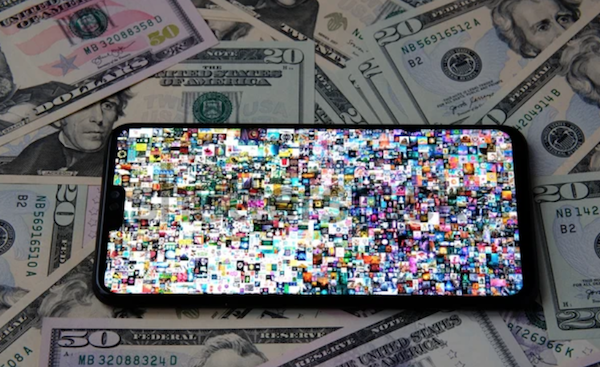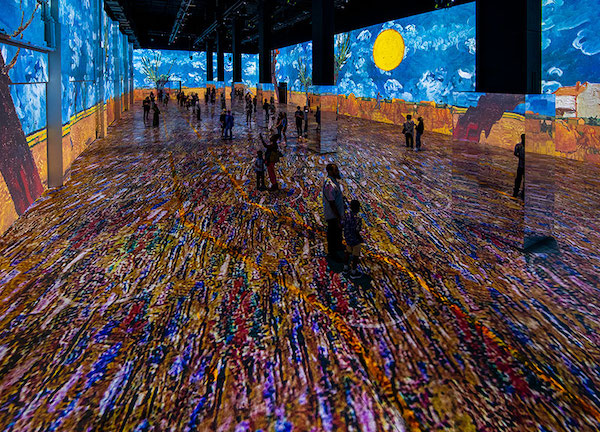The Digital Overflow in Art: Viewing Rooms, NFTS and Immersive Experiences


By GINNY VAN ALYEA
After consuming so much virutal content and aligning business practices to accomodate the shift to a more engaging and receptive online marketplace these past two years, which of these now entrenched vestiges will continue in 2022 and beyond? Many of the design and digital access features created in response to COVID’s immediate market limitations–online viewing rooms, for instance–now seem suited for the long term. Gallery clients, from the comfort of home, are able to ask galleries for custom decks to review specific artists or art that meets certain design parameters. Timed access for appointments or events creates just enough of a sense of urgency to spur collectors to show up and engage with art. In 2020 the virtual became necessary. In 2022 I sense it’s inescapable. As technology gets better faster and touches every level of our lives, it’s becoming inextricable from everything from entertainment to finance, to art. That is something we should pay close attention to.
AN AUCTION REVEALED THE MARKET
It was just over a year ago, in March 2021, when Christie’s launched non-fungible tokens into the international art consciousness when it sold the first NFT, based purely on a digital work of art, ever offered by a major auction house for $69.3 million. “Everydays: the First 5,000 Days” by the artist Beeple was the the most-expensive NFT ever sold. The price was so shocking and the concept still so weird in many ways the sale itself didn’t seem real. Suddenly, art is not just available digitally. It is digital. Since the Beeple sale, NFTs have exploded beyond the auction house. What’s perhaps more eyepopping than a hammer price of more than $60 million is, as Christie’s shared on their website, the notion that NFTs have the potential to transform how we think about and establish creation as well as ownership, and not just of art but anything we can buy. The slipperiness of provenance and authenticity of physical art is moot with the symbiosis of digital art and its perpetual link to the blockchain.Sites like OpenSea and others specializing in crypto allow collectors and lookers to see what NFTs have been created (“minted”) and when, followed by when they have been sold and in what edition, and ultimately when they’re traded. Consider the value of this eight decades from now and what this chain could mean for any surprise sales or reappearances, particularly sinister ones such as from war time looting.
“NFTs have proven to be a remarkable force in the art world,” says Gary Metzner, Sotheby’s Head of Office, Chicago, “opening up a whole new market for digital artists in such a short amount of time, while also providing a new avenue for established, more traditional artists to experiment in new forms.” Metzner elaborated on collector interest at Sotheby’s, “Since Sotheby’s first began NFT sales almost a year ago, we’ve seen a tremendous response from both digitally native collectors who are new to Sotheby’s, as well as collectors more accustomed to physical art. In a period of only about 8 months, Sotheby’s sales of NFTs hit $100 million, having never before explored this category; a remarkable feat for a 278-year-old auction house!”
You’re only young once, which as we all know is its own major advantage. NFTs seem to live, for now, in the sandbox laboratory of contemporary artists (and of course celebrities)–undoubtedly because NFTs are a fresh, new medium. Many of the most active players are ones who speak the language of crypto art best, even if it’s outside the mainstream art market, much in the way street artists have been recognized and lauded in off-market circles long before they hang 3D art on white walls. NFTs are by no means limited to art. Says Metzner, “It is a very exciting time in the world of NFTs and the art market, as NFT application has only just begun, and there is much more to discover in how NFTs can be applied across a variety fields, like pop culture, entertainment, sports, and much more.”
NFTS IN CHICAGO
This spring at EXPO CHICAGO will we see booths displaying monitors offering NFTs for sale at? Very likely. A /Dialogues panel titled Generative Art and NFTs, features artist and NFT evangelist Kenny Schachter. Schachter recently wrote on Artnet about teaming up with NFT designers to publicly raise money to benefit Ukraine through the launch of a collection entitled NFTUkraine and through NFT donations. He cited that in the first two weeks of the war against Russia, NFT sales had contributed $9 million in crypto currency, serving, also according to Artnet, as modern day war bonds.
In general Chicago’s art community hasn’t prostrated to trends the way other cities’ have. Typically there is a wait-and-see appoach to anything that could seem flash-in-the-pan.
Vertical Gallery owner Patrick Hull shared, “[Vertical hasn’t] yet participated in the release of a NFT, although we work with artists that have. I haven’t purchased a NFT -– I haven’t seen anything that I want to own -– but I actively follow the market. The industry is still in its early stages, so we will continue to evaluate if and when we will offer them.”
Collector Tim Garvey, skeptical of the appeal of NFTs and value long term shared, “NFTs are a bit opaque to me; the notion feels cold and gimmicky. I don’t understand where the attraction lies – except to the sellers. I assume once this gold rush period is over, NFTs won’t hold much sway for the average collector or art-appreciator. The concept, as I understand it, has nothing to do with the underlying merit or impact of the work.”
At least one gallery in Chicago’s Wicker Park–cheekily called imnotArt–is the city’s first brick and mortar space dedicated to NFTs, founded by a duo of collectors who opened a gallery to display the NFTs, first virtually, and now, physically once they began to build a collection.
It doesn’t seem that long ago that curators and collectors were having conversations about how to maintain and conserve works such as video stills, some of which required periodic updates to new formats, for instance from VHS to DVD to thumb-drive. Will the named museum wings of the future even be built, or will they occupy future digital realms and metaverses of major institutions?

IMMERSIVE ART
Stand in front of a painting. Think about when it was painted, who painted it, the colors, the medium, the image. Just put yourself in it–immerse yourself–for more than 30 seconds. When the world started to open up again, albeit in fits and starts following the initial phase of life during COVID, business owners and event organizers needed to do something to get people not just out of the house but willing to put down money for tickets.
What tickets did they buy? 2021 in Chicago saw the raging success, and some puzzlement of more than a few in the local art market, of Immersive Van Gogh, a show that sold hundreds of thousands of tickets for $40 and up. It was essentially a sunflower and star-filled light show, where on some mornings you could do yoga. Immersive Van Gogh, appealed to everyone who wanted to get out and see something new, but familiar, and very colorful. Because of its digital nature, the experience ran in multiple cities, even much smaller markets, simultaneously. When it finished its Chicago run, Immersive Frida took its place– pausing only for a special edition, Immersive Shevchenko: Soul of Ukraine, that raised over $200,000 for Ukraine. There will undoubtedly be more editions, running through the list of the world’s most famous, and licensed, artists.
The addiction to buzzy, fast moving tech-art experiences has the potential to overshadow the real thing–the works that inspired today’s reimagined art in the first place. Though the temptation won’t go away, maybe some works are better left as they are. The digital is here and everywhere, but a summer without restrictions could mean that you can also buy a regular old museum ticket. Stand in front of a photograph or an installation for longer than you normally would. Put down your phone. See what happens. When no one else is looking.






